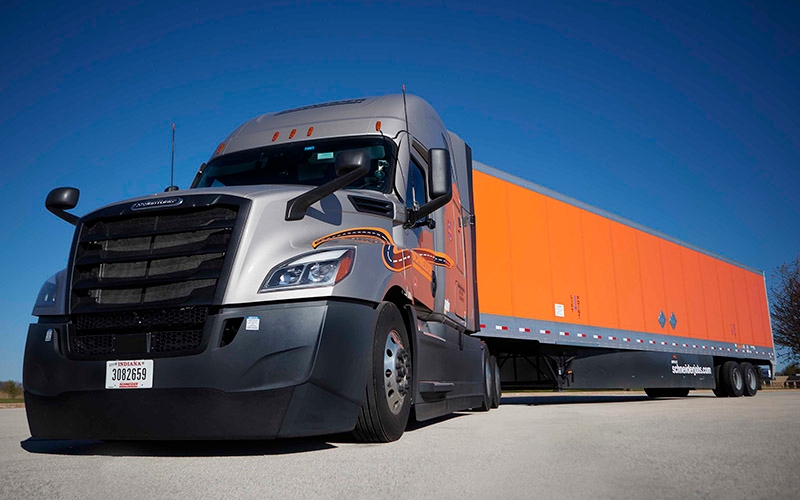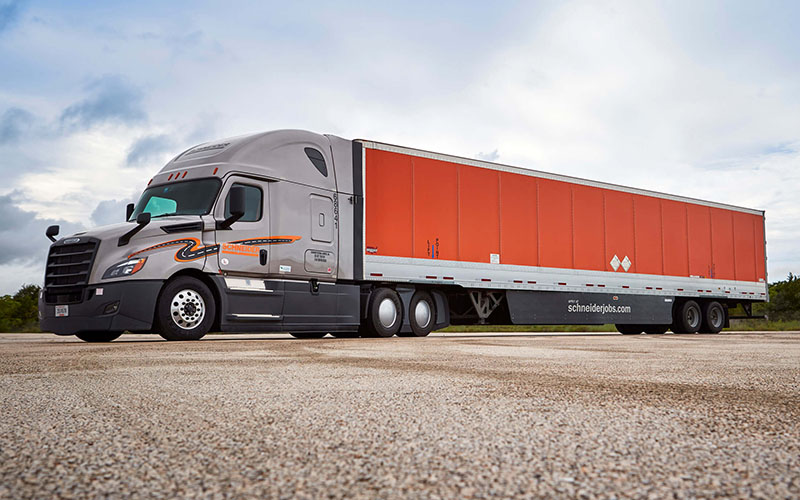
A semi-truck is defined as a truck with a trailer hitched to it, including a tractor unit and one or more semi-trailers. Semi-trucks are large, heavy-duty trucks used for transporting goods over long distances.
They consist of a powerful engine, spacious cabin for the driver, and large cargo-carrying capacity. These trucks are designed for hauling heavy loads and are a vital part of the transportation industry for long-haul deliveries. Featuring a distinctive cab and trailer design, semis are commonly seen on highways and major roads, symbolizing the backbone of commercial freight transportation.
With their distinct appearance and sheer size, semi-trucks are a recognizable and essential aspect of the logistics and shipping sector.

Credit: schneiderjobs.com
Navigate As You Want:
1. Size And Weight
Semi trucks are known for their massive size and heavy weight, making them a formidable presence on the roads. The most striking characteristic of these trucks is their length, which can vary depending on the type of trailer attached. On average, a semi truck measures around 70 to 80 feet in length.
The weight of a semi truck is another defining factor. These vehicles are designed to carry substantial loads, with weight limits ranging between 80,000 to 100,000 pounds, depending on the state regulations. This weight includes the truck itself, the cargo, and any additional equipment.
Table:| Truck Dimension | Measurement |
|---|---|
| Length | Average 70 to 80 feet |
| Weight Limit | 80,000 to 100,000 pounds |

Credit: schneiderjobs.com
2. Engine And Power
Semi trucks are powered by diesel engines known for their efficiency and durability. These engines are designed to deliver high horsepower and torque, providing the necessary power for heavy hauling. With a focus on performance and reliability, semi truck engines are engineered to meet the demands of long-distance transportation. The diesel fuel used by these engines allows for enhanced fuel economy, making them a cost-effective choice for commercial transportation. Furthermore, the high torque output enables semi trucks to handle heavy loads with ease, ensuring smooth and efficient operation on the road.
3. Trailer Attachments
Semi trucks are defined by their large size, powerful engines, and multiple axles, which enable them to carry heavy loads over long distances. These trucks are designed to tow trailers, and the way the trailer is attached is a key defining feature. The fifth wheel connection is a crucial component that allows the trailer to pivot and maneuver, while different trailer types cater to specific cargo needs. Flatbed trailers are ideal for transporting large, heavy items, while refrigerated trailers are designed to transport perishable goods at controlled temperatures. Understanding these trailer attachments and types is essential in defining the capabilities and functionality of semi trucks.
4. Safety Features
One of the key factors that define a semi truck is its safety features. These features are designed to ensure the safety of the driver, passengers, and other road users. Advanced braking systems are one of the most important safety features in a semi truck. These systems use advanced technology to provide enhanced braking performance, reducing the risk of accidents. Another crucial safety feature is lane departure warning, which helps the driver stay in their lane and avoid drifting into other lanes unintentionally. This feature uses sensors to monitor the truck’s position on the road and alerts the driver if they start to veer out of their lane. Overall, these safety features play a significant role in making semi trucks safer and reducing the likelihood of accidents on the road.
5. Regulations And Licensing
A commercial driver’s license (CDL) is a crucial requirement for anyone operating a semi truck. It ensures that drivers have the necessary skills and knowledge to handle these large vehicles safely. Obtaining a CDL involves passing both written and practical exams, covering various aspects of driving a semi truck. These tests include topics such as vehicle inspection, driving skills, and knowledge of transportation regulations.
In addition to licensing, semi truck drivers must also comply with hours of service (HOS) rules. These regulations dictate the maximum number of hours a driver can be on duty and driving within a specific timeframe. HOS rules are designed to prevent driver fatigue and promote road safety. Failure to follow these rules can result in fines, penalties, and even suspension of the driver’s CDL.

Credit: www.topmarkfunding.com
Frequently Asked Questions Of What Defines A Semi Truck
What Is The Definition Of A Semi Truck?
A semi truck, also known as a tractor-trailer or a big rig, is a large vehicle consisting of a tractor unit and a trailer unit. The tractor unit contains the engine and the driver’s cabin, while the trailer unit is designed to carry freight or cargo.
These trucks are commonly used for long-haul transportation.
How Much Weight Can A Semi Truck Carry?
The weight limit of a semi truck varies depending on factors like the number of axles, the type of trailer, and federal regulations. However, the maximum weight a semi truck can legally carry is typically around 80,000 pounds, including the weight of the truck itself and the cargo it is hauling.
What Are The Dimensions Of A Semi Truck?
The dimensions of a semi truck also vary, but the typical length of a tractor unit is around 20 to 30 feet. The trailer unit can be anywhere between 28 to 53 feet in length. The height of a semi truck is usually around 13 to 14 feet, allowing it to navigate under most bridges and overpasses.
Conclusion
To summarize, a semi truck is defined by its unique characteristics – a rigid front axle, a detachable trailer, and a heavier weight capacity. Understanding these features helps to differentiate semi trucks from other vehicles. Whether it’s hauling goods across the country or delivering supplies locally, semi trucks play a vital role in the logistics industry.
So next time you see a big rig on the road, you’ll know what truly defines it.




